
The Giraffidae are a family of ruminant artiodactyl mammals that share a common ancestor with deer and bovids. This family, once a diverse group spread throughout Eurasia and Africa, presently comprises only two extant genera, the giraffe and the okapi. Both are confined to sub-Saharan Africa: the giraffe to the open savannas, and the okapi to the dense rainforest of the Congo. The two genera look very different on first sight, but share a number of common features, including a long, dark-coloured tongue, lobed canine teeth, and horns covered in skin, called ossicones.

Deinotheriidae is a family of prehistoric elephant-like proboscideans that lived during the Cenozoic era, first appearing in Africa, then spreading across South Asia (Indo-Pakistan) and Europe. During that time, they changed very little, apart from growing much larger in size; by the late Miocene, they had become the largest land animals of their time. Their most distinctive features were their lack of upper tusks and downward-curving tusks on the lower jaw.

Amphicyon is an extinct genus of large carnivorans belonging to the family Amphicyonidae, subfamily Amphicyoninae, from the Miocene epoch. Members of this family received their vernacular name for possessing bear-like and dog-like features. They ranged over North America, Europe, Asia, and Africa.
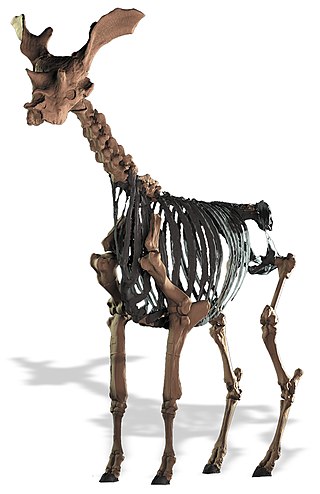
Sivatherium is an extinct genus of giraffid that ranged throughout Africa and Eurasia. The species Sivatherium giganteum is, by weight, one of the largest giraffids known, and also one of the largest ruminants of all time.
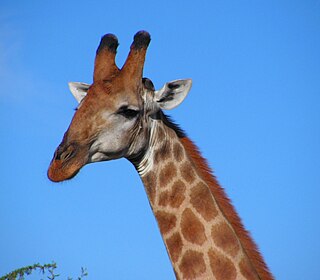
Ossicones are columnar or conical skin-covered bone structures on the heads of giraffes, male okapi, and some of their extinct relatives. Ossicones are distinguished from the superficially similar structures of horns and antlers by their unique development and a permanent covering of skin and fur.

Giraffokeryx is an extinct genus of medium-sized giraffids known from the Miocene of the Indian subcontinent and Eurasia. It is distinguished from other giraffids by the four ossicones on its head; one pair in front of the eyes on the anterior aspect of the frontal bone and the other behind the eyes in the frontoparietal region overhanging the temporal fossae. It has a brachydont dentition like in other giraffids and its legs and feet are of medium length. Giraffokeryx is considered monotypic by most authors, in the form of G. punjabiensis, but other species have been assigned to the genus:
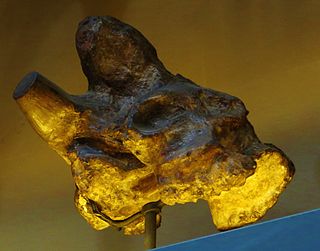
Bramatherium is an extinct genus of giraffids that ranged from India to Turkey in Asia. It is closely related to the larger Sivatherium.

Samotherium is an extinct genus of Giraffidae from the Miocene and Pliocene of Eurasia and Africa. Samotherium had two ossicones on its head, and long legs. The ossicones usually pointed upward, and were curved backwards, with males having larger, more curved ossicones, though in the Chinese species, S. sinense, the straight ossicones point laterally, not upwards. The genus is closely related to Shansitherium. Fossil evidence suggests that Samotherium had a rounded muzzle, which would suggest a grazing lifestyle and a habitat composed of grassland. One common predator of this animal was the Amphimachairodus.
Hydaspitherium is an extinct genus of giraffid artiodactyls that lived during the Cenozoic era during the Miocene epoch to the Pliocene epoch in Pakistan. Giraffids are represented in the late Miocene epoch of the Siwaliks by large Sivatheriinae such as Sivatherium, Bramatherium, Helladotherium, and Hydaspitherium. Hydaspitherium has been proposed to be synonymous with Bramatherium. H. megacephalum is restricted to the Dhok Pathan Formation in northern Pakistan.
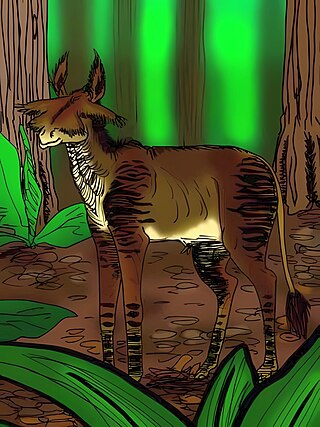
Injanatherium is an extinct genus of giraffids from the Miocene of Iraq, Saudi Arabia, and Pakistan. Species of Injanatherium had at least two pairs of long, wing-like ossicones that emanated laterally above the orbits.
Tyarrpecinus is an extinct genus of thylacinid that lived during the late Miocene in what is now the Northern Territory, Australia. It is known only from a partial skull bone that was reconstructed from numerous fragments. It was a small thylacinid and represents a late surviving relict. The genus is monotypic, containing only one species, Tyarrpecinus rothi.

Palaeotragus is a genus of very large, primitive, okapi-like giraffids from the Miocene to Early Pleistocene of Africa and Eurasia.

Xenastrapotherium is an extinct genus of astrapothere, a type of hoofed herbivorous mammal, native to South America, which lived in the Middle to Late Miocene period, typically during the Laventan stage. It is a member of the family Astrapotheriidae in the subfamily Uruguaytheriinae, large astrapotheres, equipped with a trunk-like nose and protruding teeth, similar to the elephants, but their tusks were the canine teeth, not the incisors. Xenastrapotherium was a genus widely distributed in northern South America, in contrast to other species of astrapotheres which lived in the area of the Southern Cone of the continent. It differed from other astrapotheres by having two lower incisors on each side of the jaw and the tusks have a pronounced longitudinal curvature, although their general shape and size are probably very similar to Astrapotherium, whose weight would be 900 to 1,500 kilograms, comparable to the current black rhinoceros.

Hilarcotherium is an extinct genus of astrapotheriid mammals that lived in South America during the Middle Miocene (Laventan). The type species is H. castanedaii, found in sediments of the La Victoria Formation, part of the Honda Group in the department of Tolima in Colombia. In 2018, Carrillo et al. described a partial skull and mandible of a second species H. miyou from the Castilletes Formation in the Cocinetas Basin of northern Colombia, and estimated the body weight of the animal at 6,465 kilograms (14,253 lb).

Enhydriodon is an extinct genus of mustelids known from Africa, Pakistan, and India that lived from the late Miocene to the early Pleistocene. It contains nine confirmed species, two debated species, and at least a few other undescribed species from Africa. The genus belongs to the tribe Enhydriodontini in the otter subfamily Lutrinae. Enhydriodon means "otter tooth" in Ancient Greek and is a reference to its dentition rather than to the Enhydra genus, which includes the modern sea otter and its two prehistoric relatives.

Australotitan is an extinct genus of possibly titanosaurian somphospondylan dinosaurs from the Late Cretaceous Winton Formation (Cenomanian–Turonian) of southern-central Queensland, Australia. The genus contains a single species, A. cooperensis, known from multiple partial skeletons. The genus Australotitan may be synonymous with Diamantinasaurus, a contemporary relative.
Vishnufelis is a fossil genus of feline (cat) containing only a single species, Vishnufelis laticeps. It was described by Guy Ellcock Pilgrim in 1932, based on the first cranial material of a cat found in Asia: a fragmented skull found in the Chinji Formation, which dates back to the middle Miocene.
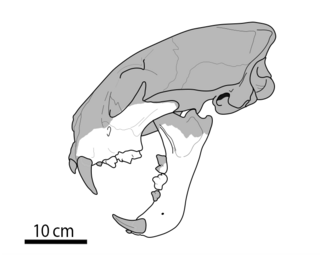
Pachypanthera is an extinct genus of pantherine felid that was recovered from the Late Miocene-aged Khorat sand pits in northeastern Thailand. It contains a single species, Pachypanthera piriyai, named and described in 2023.
Vishnuictis is an extinct genus of viverrid known from the Middle Miocene to Pleistocene of India, Pakistan, China, and Kenya. It is named after Vishnu, one of the primary Hindu deities.
Lyra is an extinct genus of giraffid artiodactyl ungulates from the Miocene Chinji Formation of Pakistan. The genus contains a single species, L. sherkana, known from a partial skull and fragmentary ossicones. Lyra may be a member of the subfamily Sivatheriinae. If this classification is correct, it would represent the oldest known sivathere.














